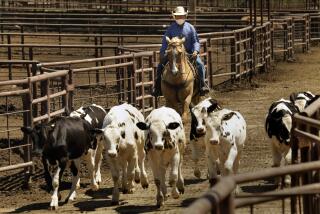A Beef With Technology : Rancher’s Genetic Research Guides Him to Meat Success
- Share via
VAN, Texas — EagleCrest Ranch Inc. has more than 500 Simbrah cattle on 1,000 acres near this burg 71 miles from Dallas. But any resemblance to the old Wild West ends there.
*
EagleCrest uses an office in north Dallas and employs sophisticated computer-driven genetic research to develop its target product--flavorful, tender, all-natural beef with no more than 7% fat.
Owner Glen Hinckley sees himself not as a traditional rancher, but as a businessman targeting a specific, lucrative market.
“A cattleman in the 21st Century is going to have to be part nutritionist, part geneticist and part rancher,” Hinckley said. “I just don’t think he can get there the way his granddad did it, because the market has changed and you have to move to the market. . . . There are too many competing meat products.”
In Hinckley’s eyes, EagleCrest Ranch is a factory.
“What we have is a natural resource here of green protein--grass, forage--and I use a bovine manufacturing machine, which is a cow, to convert that into red protein--tasty, tender red meat,” he said.
Hinckley, who has a background in marketing research, has personally interviewed consumers in grocery stores to try to learn what they’re looking for in their beef. Robin Murphy, retail manager for the Texas Beef Council, said EagleCrest is on the right track.
“Everybody is becoming aware and starting to be curious about what their cattle produce. A lot of cattle producers think of themselves as being in the cattle business, rather than in the food business.
“More and more it’s dawning on the industry that we are in the food business,” she said.
Hinckley’s approach has led him to focus on a growing field that uses data gathered from cattle carcasses to learn more about positive genetic traits. Traditionally, cattle breeders have been more concerned with traits that bring success in the show ring rather than in more consumer-oriented arenas.
*
“I’m looking at what’s on the inside,” Hinckley said.
Hinckley analyzes the records he has compiled on hundreds of cattle over the past six years. The ranch has identified eight blood lines of animals that will yield consistently choice grades of beef, have large rib eyes and good flavor.
Hinckley, who uses a laptop computer when he’s out in the pasture inspecting his cattle, credits high technology for the advances EagleCrest has made.
“You simply couldn’t go in with a herd of 500 animals and conclude things about them without the power of the computer,” Hinckley said. His daughter, Leslie, 23, whose college nutrition project helped inspire Hinckley, is the computer analyst on the family-owned ranch.
Hinckley also has a collection of over 30,000 straws of bull semen and more than 1,000 embryos, which give him added flexibility in working with genetics.
*
Affectionately called Dr. Moo by his children, Hinckley, 53, is a graduate of Texas Christian University’s ranch management program. He also has a master’s degree in marketing research from Southern Methodist University and did marketing for Southwestern Bell Telephone Co. for nine years before going into real estate.
Hinckley stumbled onto Simbrah cattle when he acquired some in satisfaction of a debt. He found them so impressive that he sold his other herds. Hinckley also paid $250,000 for a herd of 105 Simbrah cattle, including four clones, from Granada BioSciences, a now-defunct Houston company that researched genetic improvements in animals.
Simbrah, a registered breed developed in the past two decades in south Texas, is a composite of five-eighths Simmental--known for its high growth and muscling--and three-eighths Brahman, renowned for its heat tolerance and mothering.
The ranch’s prize Simbrah is Chairman, a bull weighing 2,400 pounds.
Hinckley has just begun adding Parthenaes, French cattle used in making cheese, in hopes of getting fork-cutting tenderness in his beef mix.
“I’ve got plenty of muscle now, but I’m adding a little more tenderness to that equation,” Hinckley said.
His slant toward the consumer makes Hinckley rare in the cattle industry, where ranchers often focus on making money in their narrow niche rather than on the big picture, said Mark Miller, a professor of meat science at Texas Tech University, which is carrying out a study on EagleCrest cattle.
“Glen is one of the few people who is taking it, I guess you could say, from the pasture to the plate, or from conception to consumer,” Miller said.
*
The Tech project will study EagleCrest’s cattle to see how acceptable they are to consumers, so that information can be used in making breeding decisions.
DNA from each of the 150 or so EagleCrest animals already has been captured in blood samples, and the carcass of each slaughtered animal will be evaluated for leanness, fat, marbling and quality.
The research is a step toward trying to give consumers exactly what they want, Miller said.
“People want lean, good-tasting beef,” he said. “The beef industry is listening.”
“I think it’s the way that the industry is headed, and I think that for it to survive and to maintain its market share that more and more cattle producers are going to follow that direction,” Miller said. “There’s no doubt about that. They’re going to have to.”
Hinckley said, “It’s a great time to be an American rancher. . . . The market has changed and it’s going to force the cattleman to change.”
More to Read
Inside the business of entertainment
The Wide Shot brings you news, analysis and insights on everything from streaming wars to production — and what it all means for the future.
You may occasionally receive promotional content from the Los Angeles Times.










